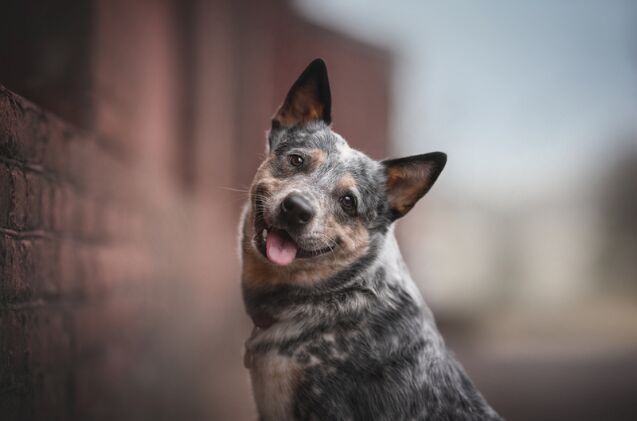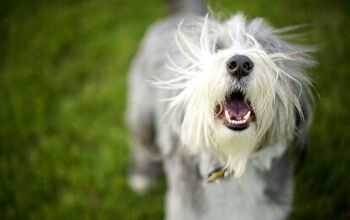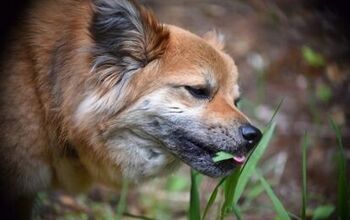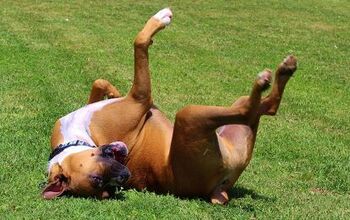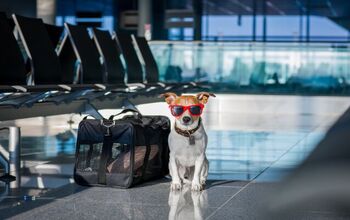Why Does My Herding Dog Nip People?

Does your playful pup turn into a little velociraptor anytime they are around guests or even family members (especially children)? It’s a common struggle with herding dogs, but it doesn’t have to continue frustrating you for the rest of their lives!
Herding dogs were bred with strong instincts to manage and control the movement of livestock. While that behavior is helpful when working in the fields, it can translate into unwanted nipping in everyday life.
In this article, we’ll explain why herding dogs nip and, more importantly, how to train them to show their affection in a more acceptable way.
What are the Personality Traits of a Herding Dog?
Before focusing on this specific problem behavior, let’s take a step back and start at the beginning. What is a herding dog, and what personality traits are they most known for?
Dogs classified in the Herding Group were bred specifically to gather, herd, and protect livestock. This means that they were bred with instincts that would help them perform their jobs safely and effectively.
Some of the more common herding breeds include:
- Australian Cattle Dog
- Australian Shepherd
- Bearded Collie
- Belgian Malinois
- Border Collie
- Collie
- German Shepherd Dog
- Old English Sheepdog
- Pembroke Welsh Corgi
- Shetland Sheepdog
These dogs are athletic and agile, allowing them to work with livestock on any terrain. They are also incredibly smart and can learn to follow even the most subtle hand movements. This means they are highly trainable but also have high exercise needs.
Why Does My Herding Dog Nip People?
Okay, these dogs are highly intelligent and full of energy – but how does that translate to nipping? If this is your first time living with a herding dog, you may be concerned that your dog has aggressive tendencies after seeing them nip at peoples’ ankles. You may be relieved to learn that this isn’t actually a sign of aggression.
When your herding dog nips at someone’s feet or heels, they are tapping into their natural instincts. They are attempting to herd that person, just as they would with livestock in the field. Understanding this can help you view their behavior in a different light.
The herding behavior is more likely to be triggered when someone mimics livestock in their eyes, running or playing around. Children are often on the receiving end for this reason, which can create a concerning situation.
What is the Difference Between a Bite and a Nip?
It is important to understand that there is a distinct difference between a bite and a nip. Recognizing this is essential for identifying whether you are dealing with natural herding behavior or a more serious situation.
A dog that is biting will grab onto their target with intention. If they make contact, they usually break the skin and draw blood. This can be made worse as they shake, tear, or tug. A bite is generally driven by either aggression or fear and is meant to inflict damage.
On the other hand (or paw), a nip is usually meant as more of a warning size. This could happen when a dog is nervous or fearful, telling someone to back off. It is also how herding dogs warn livestock to get moving.
Do Some Dogs Show Affection by Nipping?
Is nipping always a sign of fear or control? There are times when a dog could use their mouth as a way of communicating playfulness or affection. Known as “mouthing,” this is a type of play often seen in young puppies, but it doesn’t always end as a dog gets older. Many adult dogs still use play-biting to show the people in their lives that they trust and enjoy interacting with them.
However, even if your dog mouths to show affection, you don’t have to accept that as a regular behavior. Encouraging this type of play could be problematic, especially if you live in a house with smaller animals or young children.
How Do I Stop My Herding Dog from Nipping?
If herding behavior is causing trouble, don’t worry – there are ways you can address the nipping to create a happy house for everyone involved (including your guests).
Teach the “Place” Command
Have you already taught your dog the “place” command to prevent them from being too excitable when guests come through the front door or keep them from begging when you’re at the dinner table? This useful obedience command is also great for managing your dog’s herding behavior.
The “place” command instructs your dog to go to a set location, such as a bed or mat, and stay until they are released.
To teach this command, start by choosing a location. For our pup Lucifer, we use a blanket, as it is easy to bring with us when we travel. Using a treat, lure your dog to the designated spot and reward them when they place at least one paw onto the mat or bed. Repeat this, slowly increasing your expectations - one paw, two paws, four paws.
When they reliably place all our paws onto the mat each time, introduce the next stage and ask them to sit before rewarding them. After that, move on to asking them to lie down and then asking them to stay.
Make sure you are doing this slowly, taking baby steps. Ensure your dog is performing the current stage of the training reliably before moving to the next.
After you have gone through the complete behavior, meaning the “place” command tells them to go to their designated spot, lie down, and stay until released, you can start testing your pup by moving further away or adding distractions. This will reinforce what is expected of them, teaching them to obey the command regardless of what else may happen.
In practice, use the “place” command anytime you see a situation that could trigger herding behavior or if you see your dog becoming overstimulated around family, friends, or other guests.
Counterconditioning for a New Response
With counterconditioning, many dogs can be taught to respond to a situation differently. Anytime you see your dog getting overexcited or showing that they may be about to start herding, offer a high-value treat. This will take time and consistency.
Eventually, your dog will start associating their trigger with you having that treat, choosing to turn to you instead of giving into the temptation to herd.
When you are confident that your dog’s emotional response has been rewired, you can start to phase out the treat. Try skipping the treat and instead praising your dog verbally and with affection every third time. Then, every other time.
However, even with plenty of work training and counterconditioning, you are still responsible for setting your dog up for success. Avoid putting them into high-risk situations. For example, if you know that children will be running around and playing in your main living area, consider putting your dog away in a safe space like a bedroom where they can relax.
Consider Muzzle Training
While I would love to say that you should never put your dog into a risky situation, there may be times when it’s unavoidable. This is where a muzzle can be a very valuable tool.
Muzzles have been given an unwarranted bad reputation. People often see a muzzle and assume it is a punishment or a sign of an overly aggressive or dangerous dog. However, with proper conditioning, a muzzle can open doors for your dog and offer both freedom and safety.
First, ensure you select a muzzle that fits your dog correctly. It should not restrict your dog from panting, or it could put them at risk of overheating. On the other end of the spectrum, a muzzle that is too large may be easier for your dog to slip out of, making it ineffective.
Introduce the muzzle slowly before it is ever needed. Muzzle conditioning involves creating a positive association with the tool, using treats and praise, and removing any anxiety that wearing it could trigger. In time, most dogs will realize that wearing a muzzle is no more stressful than wearing a collar.
5 Ways to Keep a Herding Dog Busy
One important consideration when raising a happy, healthy herding dog is finding ways for them to channel their energy and drive in a positive way. This means finding opportunities for both physical and mental enrichment. Here are a few of my pup Lucifer’s favorites to help you start planning:
Walk, Run, Hike, or Bike
Of course, the most obvious solution to burning excess energy is to take your dog out for a walk, run, hike, or bike. Whether you’re hitting the local trails or walking around the block, give your pup a chance to sniff. Not only will they have fun exploring their surroundings, but that “sniff time” adds a mental enrichment component to your outing, wearing them out even more.
Introduce Your Dog to a Herding Ball
A great way to let your dog tap into their herding instincts without encouraging them to chase your other pets or nip at your guests is to introduce them to a herding ball. This oversized ball is too large or heavy to be picked up and carried around. Instead, to move the ball around your yard, the dog will have to nose at it, nip it, and push it as if they are herding it.
You can purchase specialty herding balls with a protective cover like the Race & Herd Complete Herding Ball Set or a durable hard plastic ball like the Jolly Pets Push-n-Play Ball.
Use a Flirt Pole
This fun exercise tool is a great way to keep your herding dog active and strengthen your relationship by playing together. It features a long handle attached to a lure or toy to entice your dog. When you move the flirt pole around, the lure will move, dance, and fly through the air, teasing your dog and triggering their natural desire to hunt and catch it.
The Squishy Face Studio Flirt Pole V2 is a durable option that can stand up to a lot of play, which is essential. After all, your dog isn’t going to take it easy on that lure!
Bond Over Training Sessions
Training is always a great way to challenge your dog’s mind. From basic obedience training to more elaborate tricks and challenges, training sessions are a bonding experience. Not only do they work your dog’s mind, burning energy and wearing them out, but it’s also the perfect opportunity to work on raising a well-behaved, respectful housemate.
I started working on basic obedience with Lucifer as a young puppy, but it was clear that his clever little mind would need more. He picked up on everything so quickly. After mastering the basics, we moved on to tricks like picking up his toys, identifying different toys by name, and other cute options. I also introduced him to talking buttons, challenging him to communicate with me in a more advanced way.
Turn Mealtime into a Game
Rather than just feeding your dog in a standard bowl, why not incorporate a mental enrichment element by challenging them to work for their food?
Snuffle mats are flat mats that feature strips of felt or material, pickets, folds, and other places where your dog’s food can be hidden. When feeding in a snuffle mat, your dog must tap into their foraging instincts, sniffing out and locating their meal.
Another great way to step up your dog’s mealtime is to feed them in a food puzzle. These are toys that require problem-solving to get to their food. They feature hidden doors, slides, spinners, flaps, and other fun elements. These can also be used easily between meals by placing a treat somewhere in the puzzle for your dog to find. They come in a variety of skill levels, from beginner to advanced. We recently introduced the Brightkins Brain Teaser Treat Puzzle in our house and love that it combines different elements in one puzzle.
Finally, there are interactive food and treat toys. These include toys that your dog has to move around until the food falls out and toys like the West Paw Zogoflex Toppl that can be filled and frozen before being given to your dog.
Final Thoughts: Keeping a Herding Dog from Nipping
If you share your heart and home with a herding dog, you know that their herding instincts can play an important role in their everyday lives. This isn’t a reflection of how you raised your pup or a failure to train them appropriately – it’s their natural drive.
Luckily, this behavior can be managed by training your dog to act appropriately around others and providing them with a positive outlet for their behavior.
Life with a herding dog is never boring (trust me, I know), but their love and loyalty will brighten even the darkest days.
Join the PetGuide community. Get the latest pet news and product recommendations by subscribing to our newsletter here.

Britt Kascjak is a proud pet mom, sharing her heart (and her home) with her “pack” which includes her husband John, their 2 dogs – Indiana and Lucifer – and their 2 cats – Pippen and Jinx. She has been active in the animal rescue community for over 15 years, volunteering, fostering and advocating for organizations across Canada and the US. In her free time, she enjoys traveling around the country camping, hiking, and canoeing with her pets.
More by Britt



